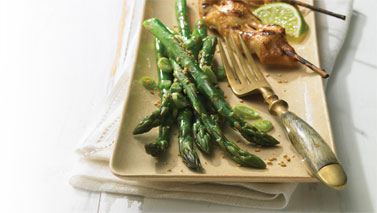Mark Bittman’s food articles have attracted a huge following — and it’s no wonder. The long-time New York Times columnist’s straightforward strategies and simple recipes, which he shares in his aptly named column “The Minimalist,” and in his latest book, Kitchen Express: 404 Inspired Seasonal Dishes You Can Make in 20 Minutes or Less (Simon & Schuster, 2009), make cooking accessible for just about anyone.
Instead of the scientific specifications that conventional recipes typically follow (“1/4 teaspoon minced garlic,” “1/2 cup pecans” and “cook to 160 degrees”), Bittman’s recipes read more like friendly advice: Add “some” minced garlic, “a handful” of pecans and cook “to the desired level of doneness.”
It’s an approach that makes cooking a breeze: You just work with what you have on hand and with ingredients that you like, without any fear that you’re doing it wrong.
“It’s actually a very old-fashioned way of explaining cooking,” Bittman told me recently by phone from his home in New York. “You can find a zillion examples like this from the ’30s and ’40s.” But sometime after World War II, he explained, Americans lost a lot of basic information and confidence about cooking, and that’s when the seemingly foolproof scientific format became commonplace.
“The traditional recipe is important in baking — you don’t want to add baking powder to taste,” Bittman admits. “But for basic, get-dinner-on-the-table cooking, it’s never made much sense.”
It’s just not the way most people cook, he explained. If you’re learning to cook French food, for instance, a cookbook like Julia Child’s Mastering the Art of French Cooking would not be that helpful. “It’s overly fussy and precise,” he said. “People don’t cook like that in French homes, restaurants or anywhere.”
People are busy, he explains. “In France, as everywhere, traditional cooking was fast. Even if one person was dedicated to running the household full-time, that person typically had so many other things to do in a day that she wasn’t sitting around thinking about how to debone individual quail for appetizers.”
After years of working with recipes, Bittman finally realized what home cooking is really all about. “It’s opening the refrigerator, seeing what’s there and making dinner. It’s not some fancy dish with a fancy name; it’s not something you need a brigade of dishwashers and prep chefs to accomplish; it’s not your whole day, it’s a part of your whole day. Sometimes a very small part.”
Upon this realization, Bittman set out to reinvent recipes for modern home cooks in his no-fuss style. “It’s deciding on a whim, ‘I’m going to make some beans with some meat,’” he said. “That’s how I cook and I encourage other people to cook. The difficulty is that beginners often don’t know how to do that — it takes some experience and some guts to decide, I like two cloves of garlic, or I like eight.”
But if you’re willing and have the courage, Bittman has the approach to make your cooking experiences quicker, easier and more enjoyable.
Asparagus and Sesame Salad
- Bunch of asparagus
- Vegetable oil
- Sesame oil
- Rice vinegar
- Soy sauce
- Sugar (optional)
- Toasted sesames
- Chopped scallions
Trim a bunch of asparagus, and if you prefer smaller pieces, cut the spears on the bias. Cook them quickly in a bit of vegetable oil for a minute or two, or until they turn bright green (you can also blanch them quickly in boiling water). Toss the cooked spears with a tablespoon or two of sesame oil, a splash of rice vinegar, a drizzle of soy sauce and a sprinkle of sugar if you like; garnish with toasted sesames and chopped scallions.
Recipe excerpted from Kitchen Express: 404 Inspired Seasonal Dishes You Can Make in 20 Minutes or Less by Mark Bittman (Simon & Schuster, 2009).
Chicken Satay With Peanut Sauce
- Chicken breasts
- Juice of one lime, plus tablespoon or two extra for sauce
- Clove of garlic
- Peanut butter
- Soy sauce
- Red chili flakes
- Brown sugar
- Chicken broth
- Salt and pepper to taste
Pound chicken breasts to half-inch thickness and slice them into 4-inch pieces. In a bowl, combine the juice from one lime with a smashed clove of garlic; add the chicken and let it marinate for five minutes. Meanwhile, whisk together a half-cup of peanut butter, a couple of tablespoons of freshly squeezed lime juice, a splash of soy sauce, a pinch or two of red chili flakes, a teaspoon of brown sugar, and enough chicken broth or water to make a smooth sauce; adjust the seasoning. Set aside most of the sauce for dipping and smear the rest on the chicken pieces with a little salt and pepper, thread onto skewers, and grill for two minutes on each side or until cooked through. Serve the reserved peanut sauce and lime wedges.
Recipe excerpted from Kitchen Express: 404 Inspired Seasonal Dishes You Can Make in 20 minutes or Less by Mark Bittman (Simon & Schuster, 2009).




This Post Has 0 Comments